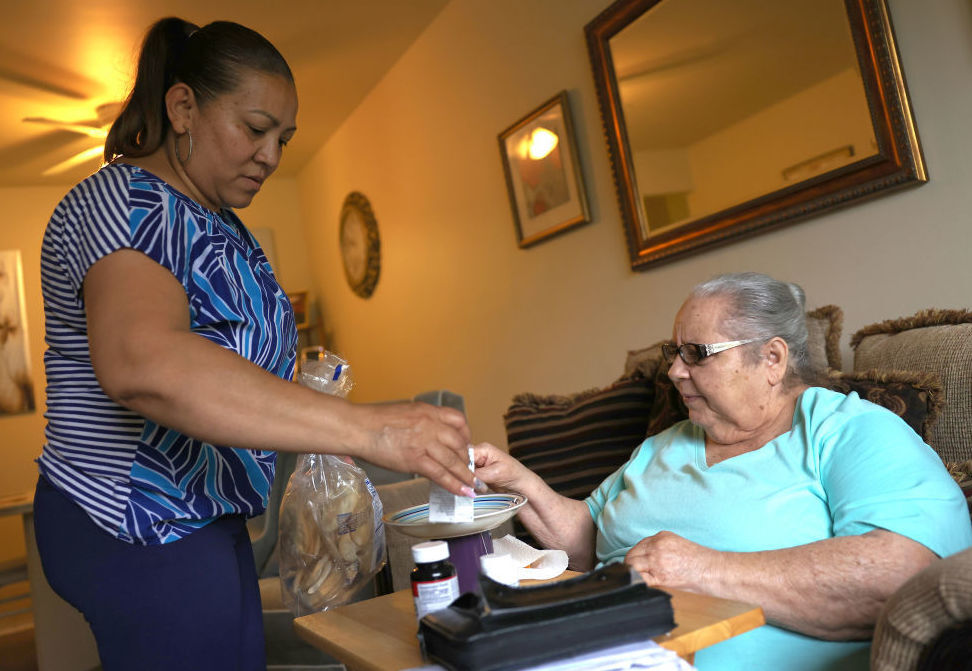
Advanced home care resources can help seniors and disabled Americans stay in their homes. Here Lidia Vilorio, a housekeeper, gives her patient Martina Negron her medicine and crackers for her tea in May in Haverstraw, NY
Michael M. Santiago / Getty Images
Hide caption
Toggle caption
Michael M. Santiago / Getty Images

Advanced home care resources can help seniors and disabled Americans stay in their homes. Here Lidia Vilorio, a housekeeper, gives her patient Martina Negron her medicine and crackers for her tea in May in Haverstraw, NY
Michael M. Santiago / Getty Images
For the elderly and people with disabilities, solving everyday practical problems can make the difference between being able to live at home or being forced to move into an institution. Sometimes people need help getting dressed or cooking. Sometimes they need help managing medication or shopping for groceries.
Originally, these things weren’t paid for by Medicaid, the government health program that many low-income Americans and disabled people rely on. Over the past few years the program has worked to increase coverage of domestic care but it’s still optional for states. Some states have largely adopted it, while in others even more care is provided in nursing homes and other facilities.
In April, the Biden government allocated funds from the American Rescue Plan to help states strengthen these services. And Thursday, the Federal Ministry for Health and Human Services revealed the plans of each state for how they will use the funds. According to one Agency press release.

“More and more people are saying that if I need care, I want it to be done at home or here in my community, rather than in an institution, hospital or nursing home,” says Health Minister Xavier Becerra. “In the 21st century, we are approaching a model of care based on providing services to the people at home.”
Becerra adds that his own father spent the last few months in the hospice at home. “When he died, he was at my house, he was surrounded by his family,” he says.
Medicaid recently surpassed 80 million beneficiaries – most since the program was developed in the 1960s. It’s the Major provider of long-term care services for the elderly as this not covered by Medicare or private insurance.
The transition to home and community care has been gradual since Medicaid’s inception, says MaryBeth Musumeci, Associate Director of the Kaiser Family Foundation’s Medicaid and Uninsured Program. “This is really the first new funding we’ve seen for home and community services since the Affordable Care Act in 2010,” she says.
“Back in 1965, the world was very different, social expectations were different,” she explains. “For example, if you had a child with a significant disability, you were much more likely to put that child into a home facility from a very young age. Medical science and technology were also not as advanced as they are now are.”
Nowadays it is possible and desirable to provide everyday help to people at home, she says.
There are many reasons why the shift to home care is a good thing, says Jack Rollins, Director of Federal Policy for the National Association of Medicaid Directors.
For someone in need of these services, “you can have your family take care of you” [or] of people you trust in the community who can come to your home, “he says.” It usually costs less than providing these services in the nursing home. People who received [these services] are generally happier with them – they prefer. “
He adds that regardless of where states are in terms of offering these services, this new funding will help move them forward. For example, he says, “One of the things Medicaid generally can’t pay for directly is internet connection – with those dollars it looks like we can.” That means people could get consistent broadband internet access, he explains, which could enable them to use telehealth services.
However, this funding boost is limited in time. The money the American Rescue Plan puts in support of these services “is a reasonable amount, but the hard part is that it is limited to 12 months,” explains Musumeci.
Many Medicaid proponents hope that more permanent support for these services will come through in the budget that will be published in Congress.
“We continue to hope that this investment will go down in some form,” says Rollins. “We think it’s important.”
The Minister of Health says he thinks so too. “We hope that Congress will continue to provide additional resources so that we can make these increased services permanent in both home and community-based settings,” says Becerra. With the COVID-19 pandemic, he adds, “Medicaid has proven its worth.”
Thank You For Reading!
Reference: www.npr.org
